Zero Reaction Torque Trajectory Tracking of an Aerial Manipulator through Extended Generalized Jacobian
Abstract
Featured Application
Abstract
1. Introduction
- Generalized Jacobian for an ideal-trolley model (Section 4): the UAV base controller maintains perfect hover conditions vertically and rotationally, with only base horizontal translations permitted. A linear trajectory tracking task is completed by a 2-DOF serial link manipulator utilizing a simplified generalized Jacobian formulation. This provides an initial exploration of the problem and demonstrates some of the limitations of purely using the generalized Jacobian for inverse kinematic control without inclusion of external forces.
- Generalized Jacobian with external forces (Section 5): the Jacobian includes the impact of all base motions, and the inverse kinematics control equation takes into account the external forces and torques such as gravity and UAV controller forces. Both 2-DOF (nonredundant) and 3-DOF (redundant) serial link manipulator cases are simulated for the trajectory tracking tasks outlined in Section 3.
- Extended generalized Jacobian (Section 6): the generalized Jacobian is extended to include an additional constraint, which is the minimization of the reaction torques on the UAV caused by the manipulator motion for a redundant 3-DOF serial link manipulator. We validate this algorithm with two trajectory tracking tasks as outlined in Section 3.
2. Background Theory
2.1. Unmanned Aerial Manipulator Dynamics and Control Model
2.2. Kinematics of Manipulators
2.3. Generalized Jacobian
- The center of gravity (CoG) of the base–manipulator system is found and the inertias of the base and links are reformulated in a CoG centered reference frame.
- The kinematic equations of the system for velocity-space are defined in the CoG frame. The Jacobians and generalized coordinates for the base component and manipulator component are decoupled:
- 3.
- The momentum conservation equations for the system in the CoG frame are defined. Similarly to (9), the base and manipulator components are decoupled:
- 4.
- Combine (9) and (10) to eliminate the unknown base variables , to find the relationship between end-effector and joint velocities:
3. Simulation Setup
- Linear trajectory with displacement of and displacement of from the initial position of the end-effector and back, to be completed within . This is implemented in the velocity space with a smoothed trapezoidal velocity profile, with an acceleration, constant velocity, and deceleration phase for the forward and backward motions. The equation defining the velocity along axis or at time for the forward motion is the following:
- 2.
- Circular trajectory with diameter , to be completed within , with the initial position of the end-effector as the topmost point of the circle. The velocity profile is generated using the procedure in [22] and is omitted here for brevity. The velocity profile and initial configuration for a 3-DOF manipulator with the kinematic and dynamic parameters outlined in Table 1 (as modeled in Section 5 and Section 6) are shown in Figure 4.
4. Ideal Control 2-DOF Trolley Model
4.1. Model Derivation
4.2. Simulation Results with Ideal Control
4.3. Simulation Results with PID Control
5. Generalized Jacobian with External Forces
5.1. Derivation of Generalized Jacobian with External Forces for Trajectory Tracking
- : vector from the inertial frame origin to the UAV CoG ;
- : vector from the inertial frame origin to the whole system CoG .
5.2. Simulation Results
6. Extended Generalized Jacobian for a 3-DOF Redundant Manipulator with Full Base Movement
6.1. Derivation of Extended Jacobian
6.2. Simulation Results for Trajectory Tracking
7. Load Picking Case
7.1. Model Derivation
7.2. Simulation Setup
- The forward motion (without payload) is accomplished from .
- The end-effector velocities are then null from and the grasp starts at so we can start to add the payload in this interval without large discontinuities in the load force.
- The backward motion begins at with a slow trapezoidal velocity profile to avoid too fast changes in the load force which would cause the UAV to lose altitude excessively.
- At , is null and the payload is entirely sustained by the manipulator so we increase the end-effector backward velocity.
7.3. Simulation Results
8. Conclusions
Author Contributions
Funding
Institutional Review Board Statement
Informed Consent Statement
Data Availability Statement
Conflicts of Interest
References
- Ollero, A.; Tognon, M.; Suarez, A.; Lee, D.; Franchi, A. Past, Present, and Future of Aerial Robotic Manipulators. IEEE Trans. Robot. 2021, 38, 626–645. [Google Scholar] [CrossRef]
- Franchi, A.; Carli, R.; Bicego, D.; Ryll, M. Full-Pose Tracking Control for Aerial Robotic Systems with Laterally Bounded Input Force. IEEE Trans. Robot. 2018, 34, 534–541. [Google Scholar] [CrossRef]
- Trujillo, M.Á.; Martínez-de Dios, J.R.; Martín, C.; Viguria, A.; Ollero, A. Novel Aerial Manipulator for Accurate and Robust Industrial NDT Contact Inspection: A New Tool for the Oil and Gas Inspection Industry. Sensors 2019, 19, 1305. [Google Scholar] [CrossRef] [PubMed]
- Park, S.; Lee, J.; Ahn, J.; Kim, M.; Her, J.; Yang, G.-H.; Lee, D. Odar: Aerial Manipulation Platform Enabling Omnidirectional Wrench Generation. IEEE/ASME Trans. Mechatron. 2018, 23, 1907–1918. [Google Scholar] [CrossRef]
- Bodie, K.; Brunner, M.; Pantic, M.; Walser, S.; Pfändler, P.; Angst, U.; Siegwart, R.; Nieto, J. Active Interaction Force Control for Contact-Based Inspection with a Fully Actuated Aerial Vehicle. IEEE Trans. Robot. 2020, 37, 709–722. [Google Scholar] [CrossRef]
- Khamseh, H.B.; Janabi-Sharifi, F.; Abdessameud, A. Aerial Manipulation—A Literature Survey. Robot. Auton. Syst. 2018, 107, 221–235. [Google Scholar] [CrossRef]
- Ruggiero, F.; Lippiello, V.; Ollero, A. Aerial Manipulation: A Literature Review. IEEE Robot. Autom. Lett. 2018, 3, 1957–1964. [Google Scholar] [CrossRef]
- Lee, J.Y.; Cook, Z.; Barzilov, A.; Yim, W. Control of an Aerial Manipulator with an On-Board Balancing Mechanism. In ASME International Mechanical Engineering Congress and Exposition; American Society of Mechanical Engineers: Phoenix, Arizona, 2016; Volume 50541, p. V04AT05A019. [Google Scholar]
- Yang, H.; Lee, D. Dynamics and Control of Quadrotor with Robotic Manipulator. In Proceedings of the 2014 IEEE International Conference on Robotics and Automation (ICRA), Hong Kong, China, 31 May–7 June 2014; pp. 5544–5549. [Google Scholar]
- AlAkhras, A.; Sattar, I.H.; Alvi, M.; Qanbar, M.W.; Jaradat, M.A.; Alkaddour, M. The Design of a Lightweight Cable Aerial Manipulator with a CoG Compensation Mechanism for Construction Inspection Purposes. Appl. Sci. 2022, 12, 1173. [Google Scholar] [CrossRef]
- Abuzayed, I.; Itani, A.R.; Ahmed, A.; Alkharaz, M.; Jaradat, M.A.; Romdhane, L. Design of Lightweight Aerial Manipulator with a CoG Compensation Mechanism. In Proceedings of the 2020 Advances in Science and Engineering Technology International Conferences (ASET), Dubai, United Arab Emirates, 4 February–9 April 2020; pp. 1–5. [Google Scholar]
- Cocuzza, S.; Rossetto, E.; Doria, A. Dynamic Interaction between Robot and UAV in Aerial Manipulation. In Proceedings of the 2020 19th International Conference on Mechatronics-Mechatronika (ME), Prague, Czech Republic, 2–4 December 2020; pp. 1–6. [Google Scholar]
- Papadopoulos, E.; Dubowsky, S. On the Nature of Control Algorithms for Free-Floating Space Manipulators. IEEE Trans. Robot. Autom. 1991, 7, 750–758. [Google Scholar] [CrossRef]
- Caccavale, F.; Siciliano, B. Kinematic Control of Redundant Free-Floating Robotic Systems. Adv. Robot. 2001, 15, 429–448. [Google Scholar] [CrossRef]
- Cocuzza, S.; Pretto, I.; Debei, S. Least-Squares-Based Reaction Control of Space Manipulators. J. Guid. Control Dyn. 2012, 35, 976–986. [Google Scholar] [CrossRef]
- Cocuzza, S.; Pretto, I.; Debei, S. Novel Reaction Control Techniques for Redundant Space Manipulators: Theory and Simulated Microgravity Tests. Acta Astronaut. 2011, 68, 1712–1721. [Google Scholar] [CrossRef]
- Umetani, Y.; Yoshida, K. Others Resolved Motion Rate Control of Space Manipulators with Generalized Jacobian Matrix. IEEE Trans. Robot. Autom. 1989, 5, 303–314. [Google Scholar] [CrossRef]
- Nenchev, D.N. Redundancy Resolution through Local Optimization: A Review. J. Robot. Syst. 1989, 6, 769–798. [Google Scholar] [CrossRef]
- Tringali, A.; Cocuzza, S. Globally Optimal Inverse Kinematics Method for a Redundant Robot Manipulator with Linear and Nonlinear Constraints. Robotics 2020, 9, 61. [Google Scholar] [CrossRef]
- Tringali, A.; Cocuzza, S. Finite-Horizon Kinetic Energy Optimization of a Redundant Space Manipulator. Appl. Sci. 2021, 11, 2346. [Google Scholar] [CrossRef]
- Siciliano, B.; Sciavicco, L.; Villani, L.; Oriolo, G. Robotics: Modelling, Planning and Control, 1st ed.; Springer Publishing Company, Incorporated: New York, NY, USA, 2008; ISBN 1-84628-641-7. [Google Scholar]
- Cocuzza, S.; Pretto, I.; Debei, S. Reaction Torque Control of Redundant Space Robotic Systems for Orbital Maintenance and Simulated Microgravity Tests. Acta Astronaut. 2010, 67, 285–295. [Google Scholar] [CrossRef]
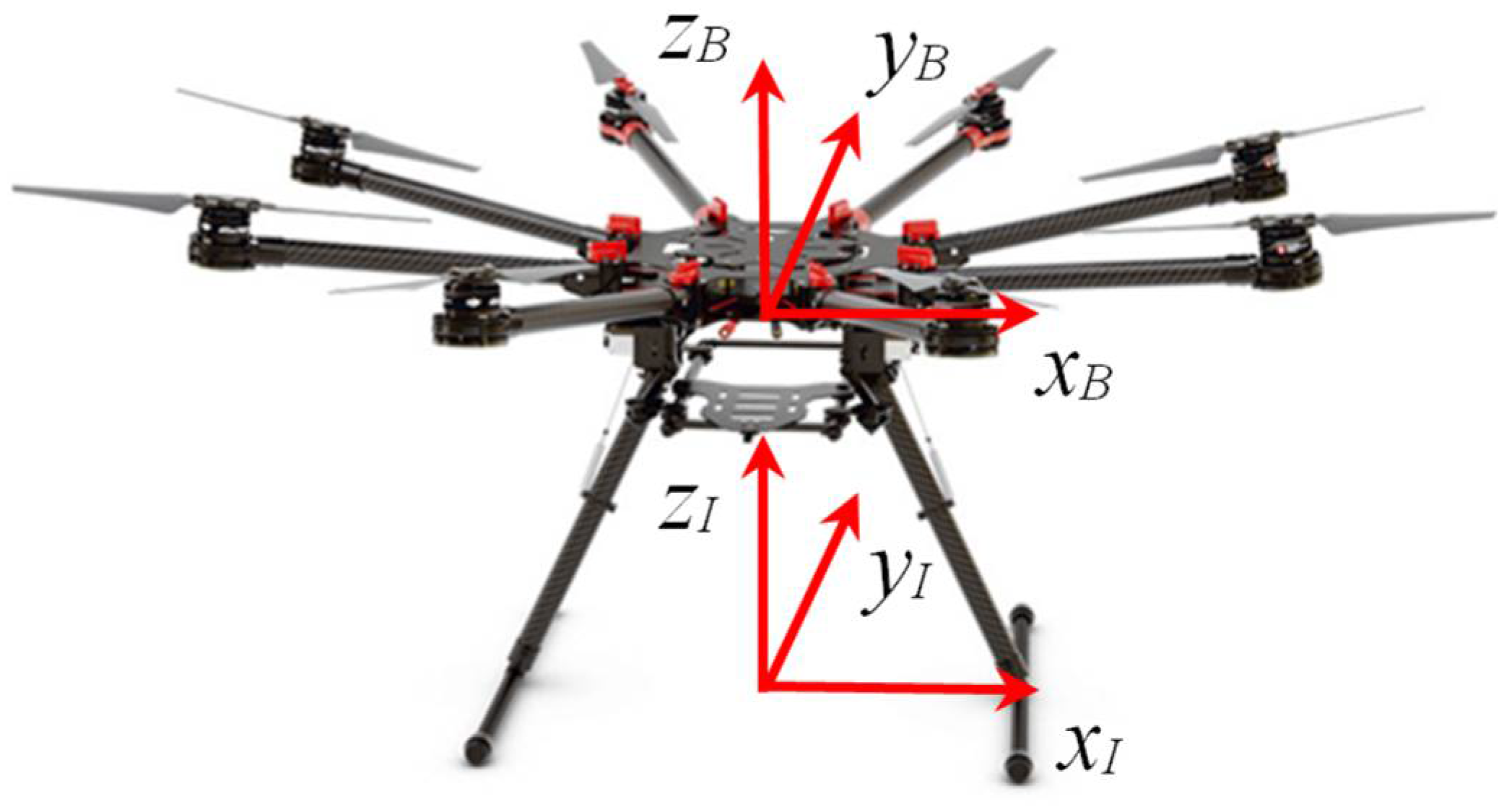
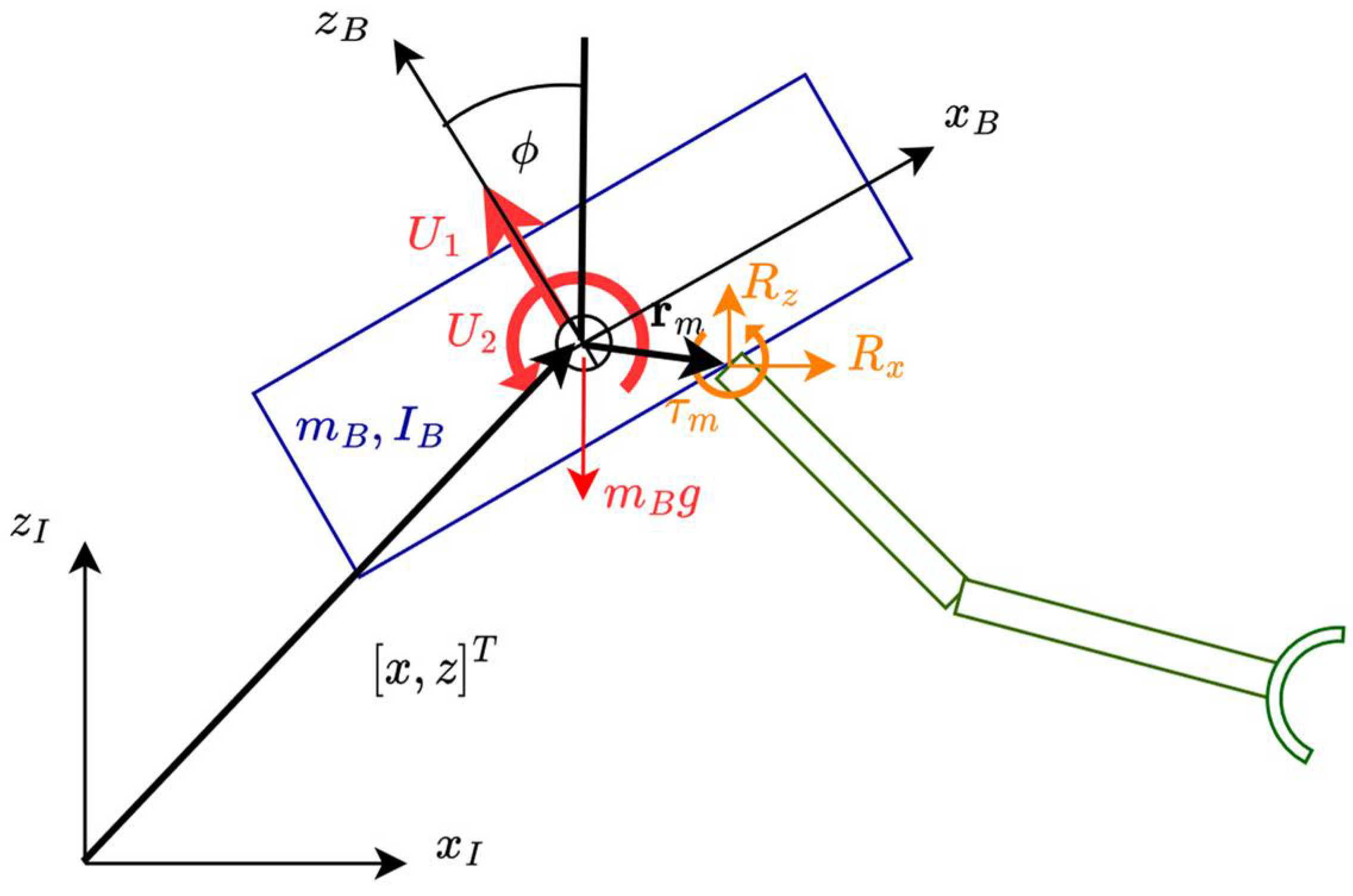
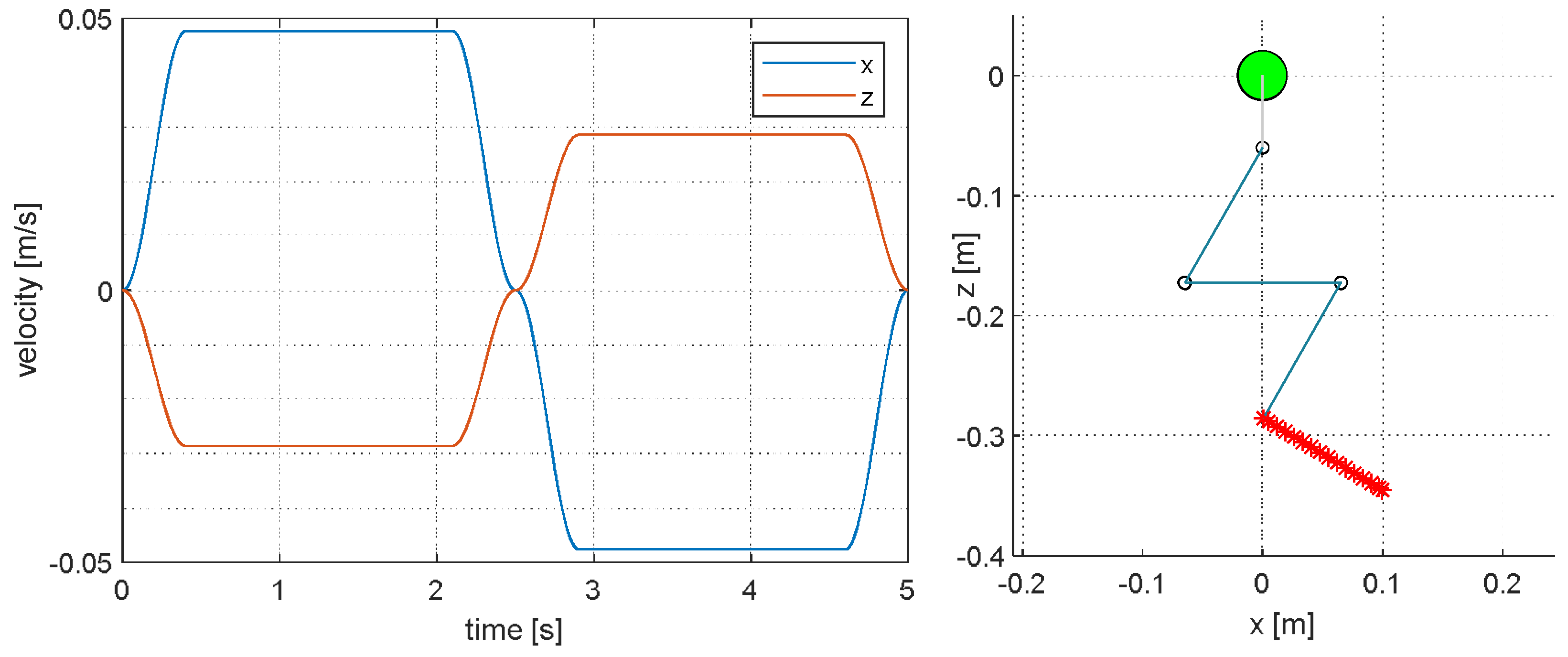
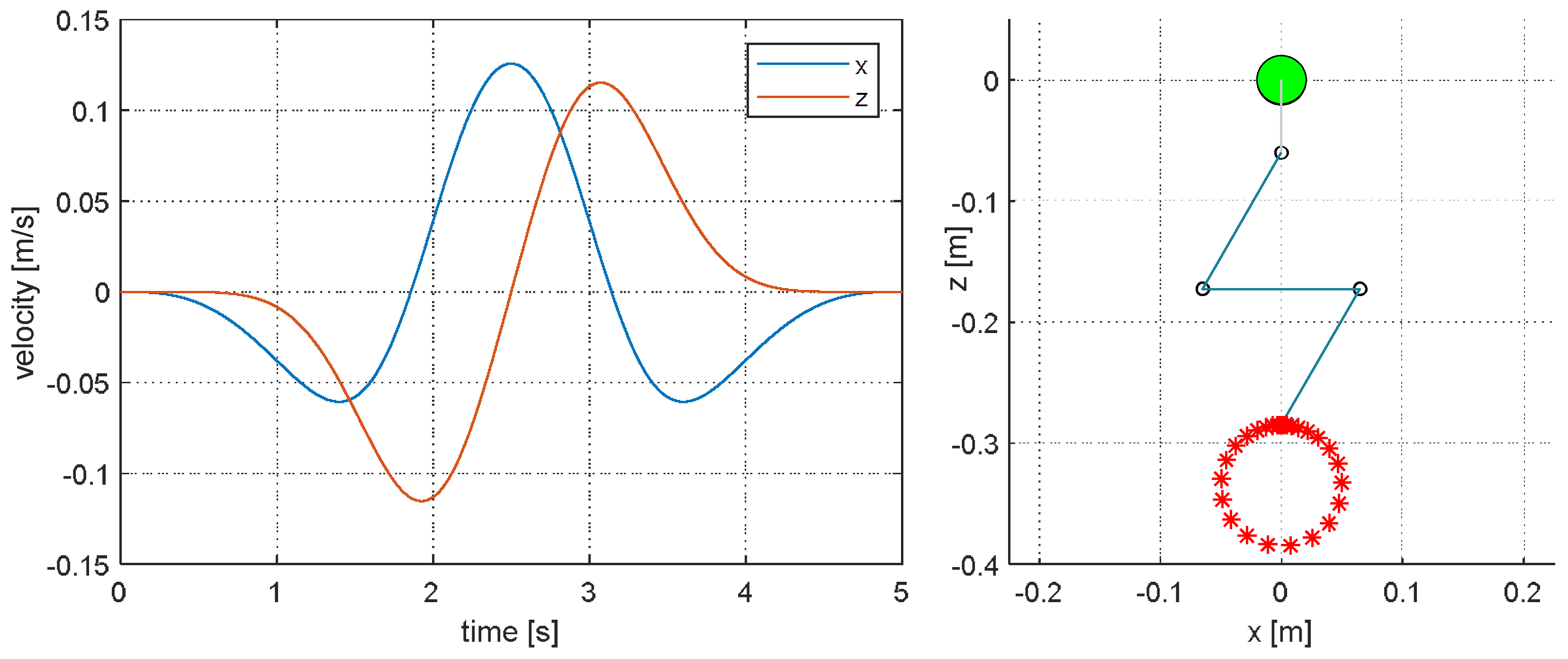

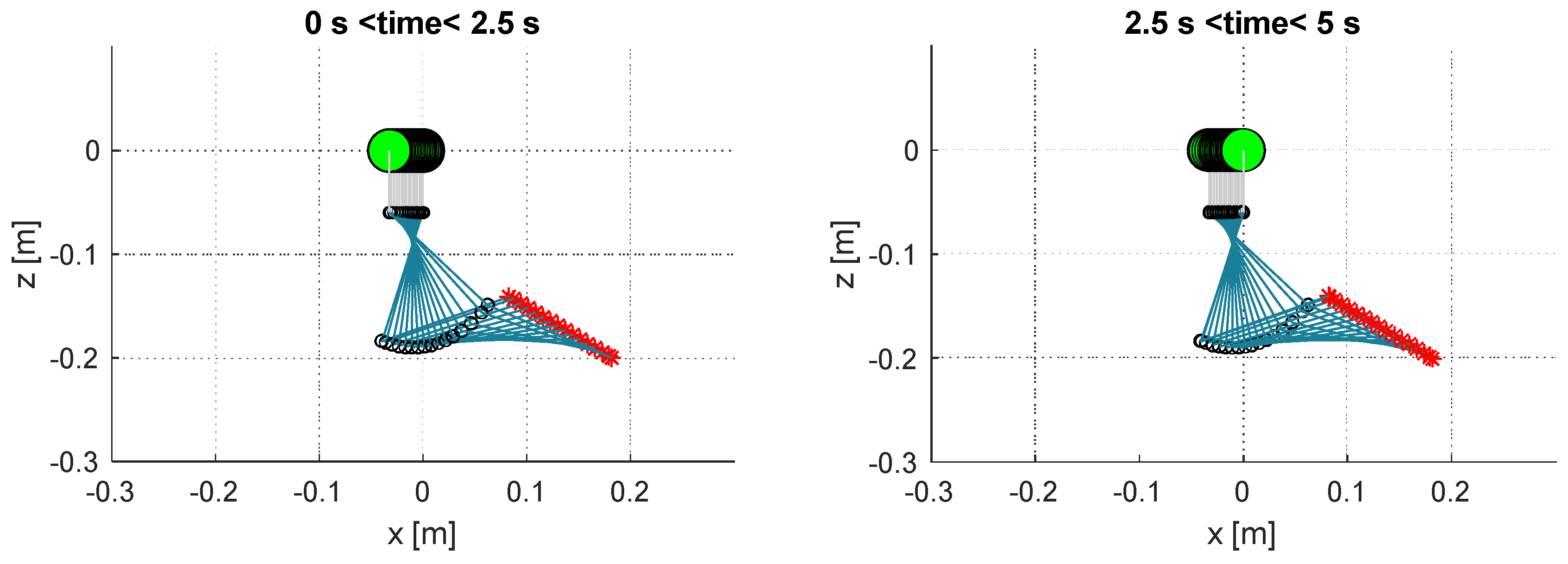
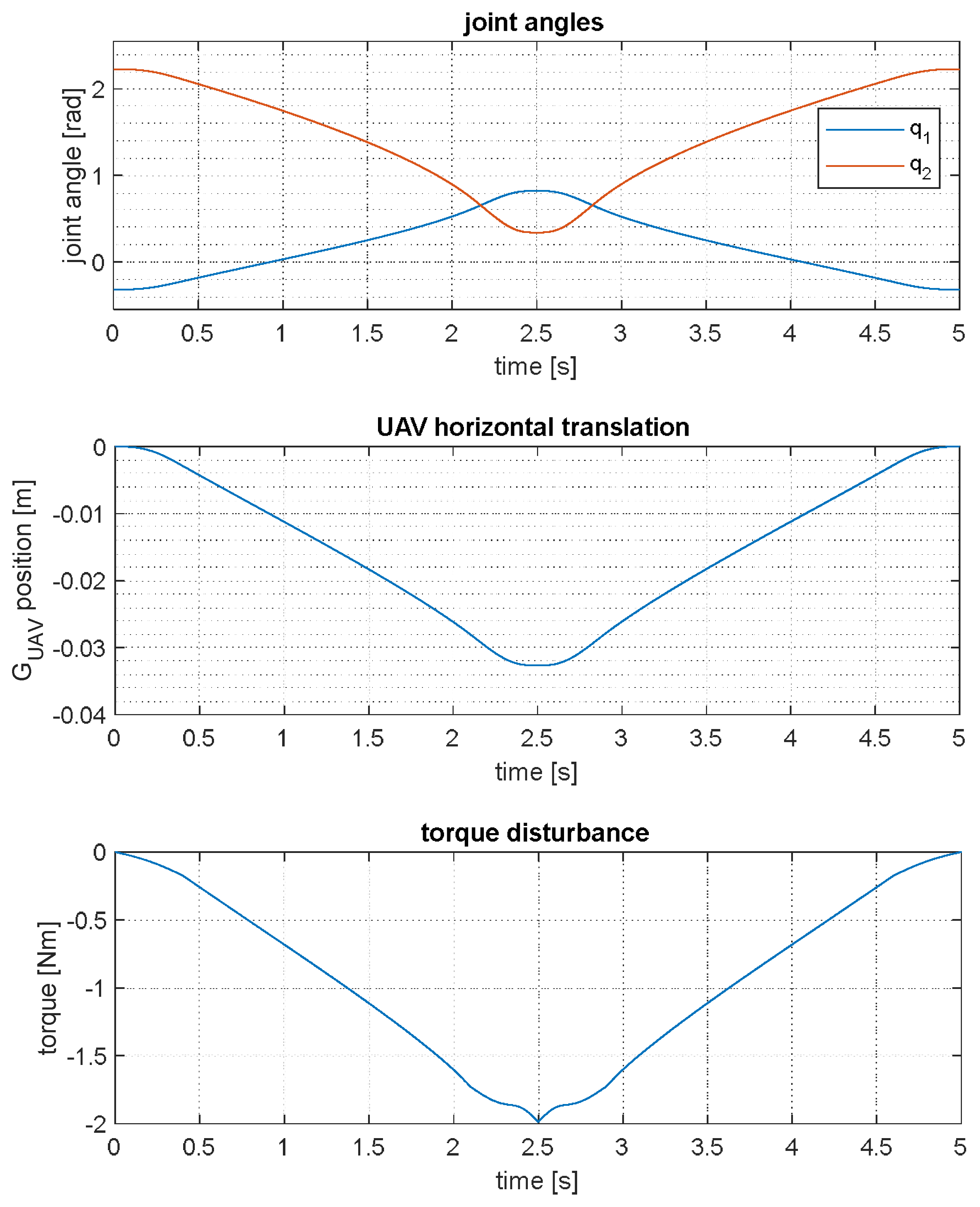
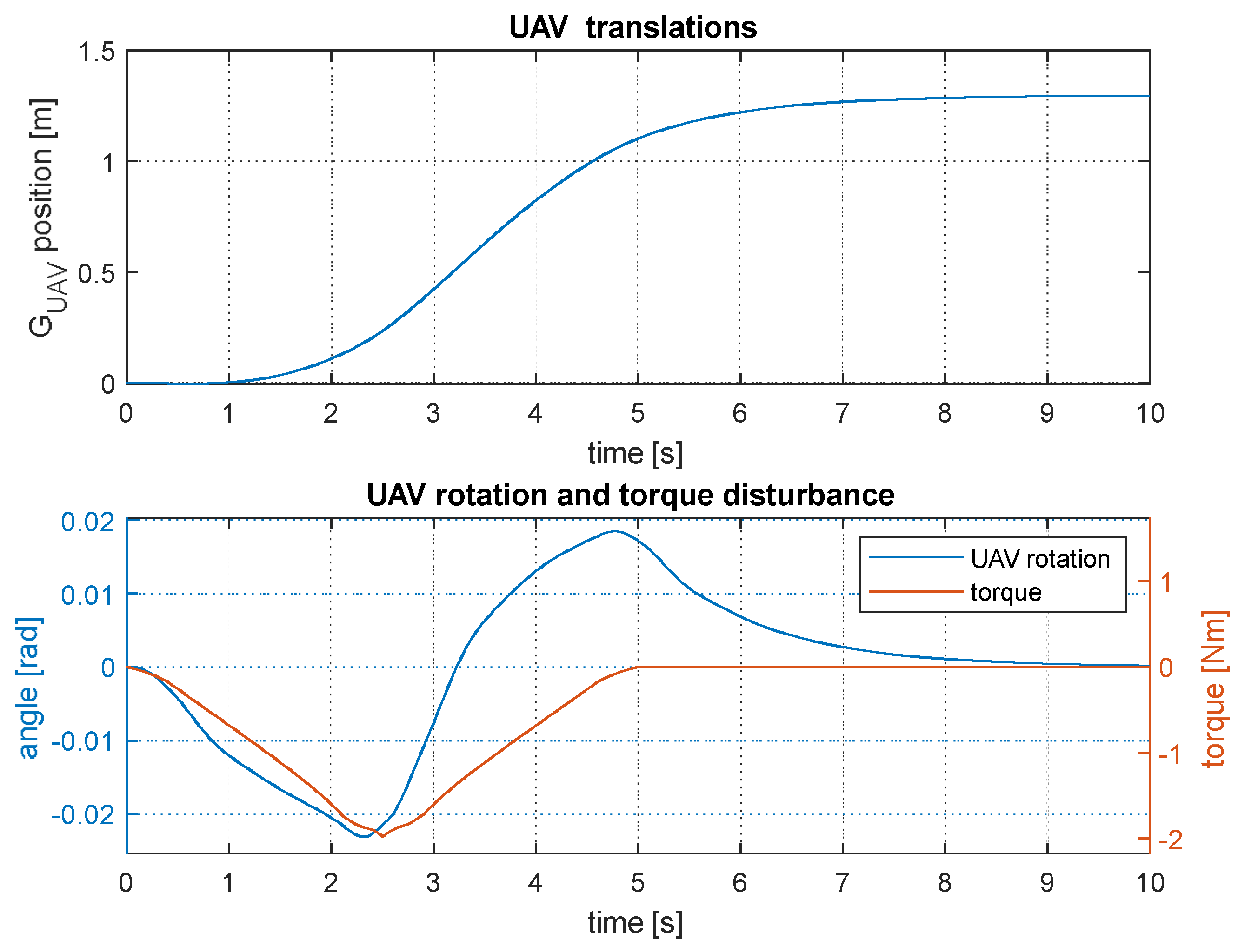
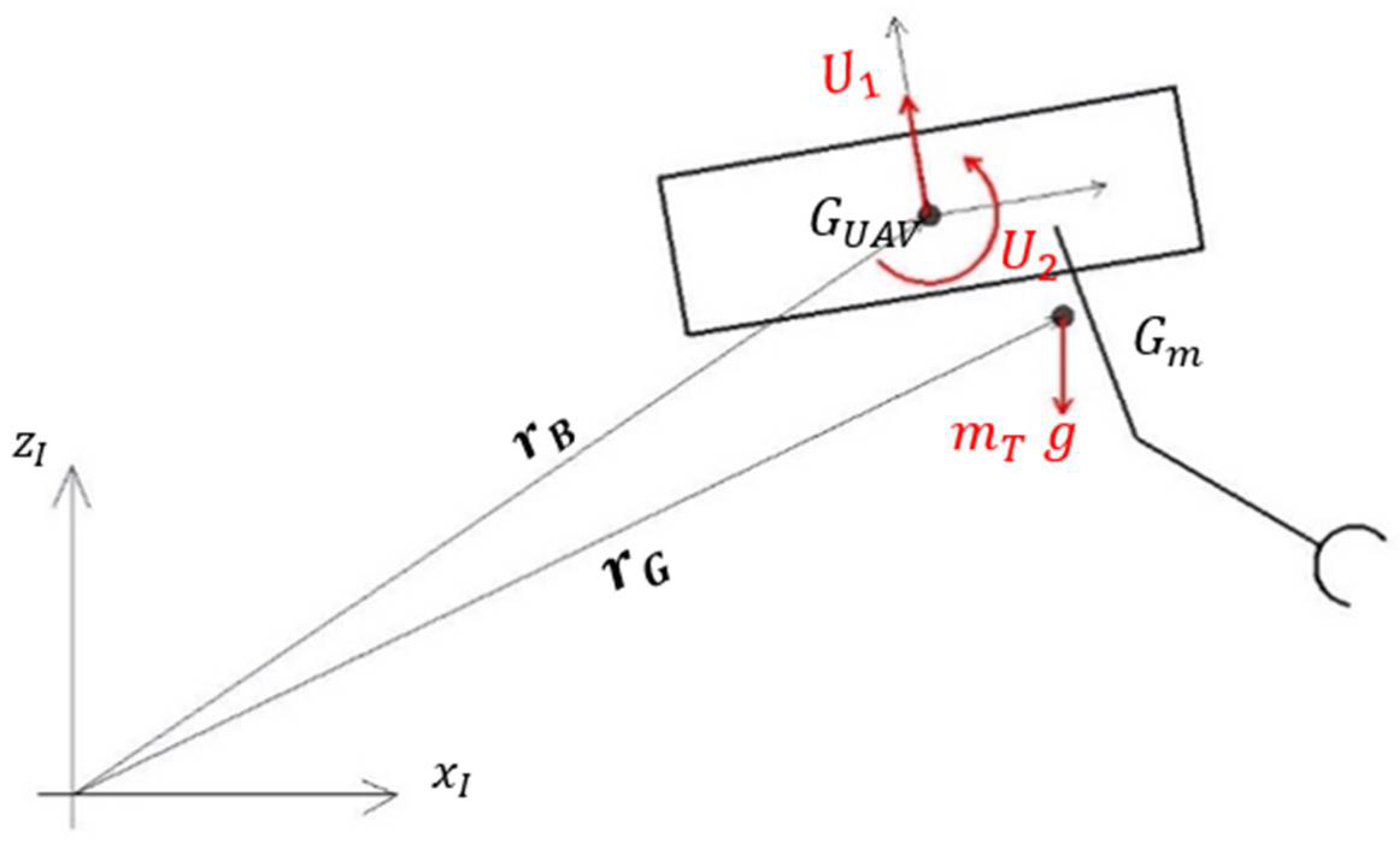
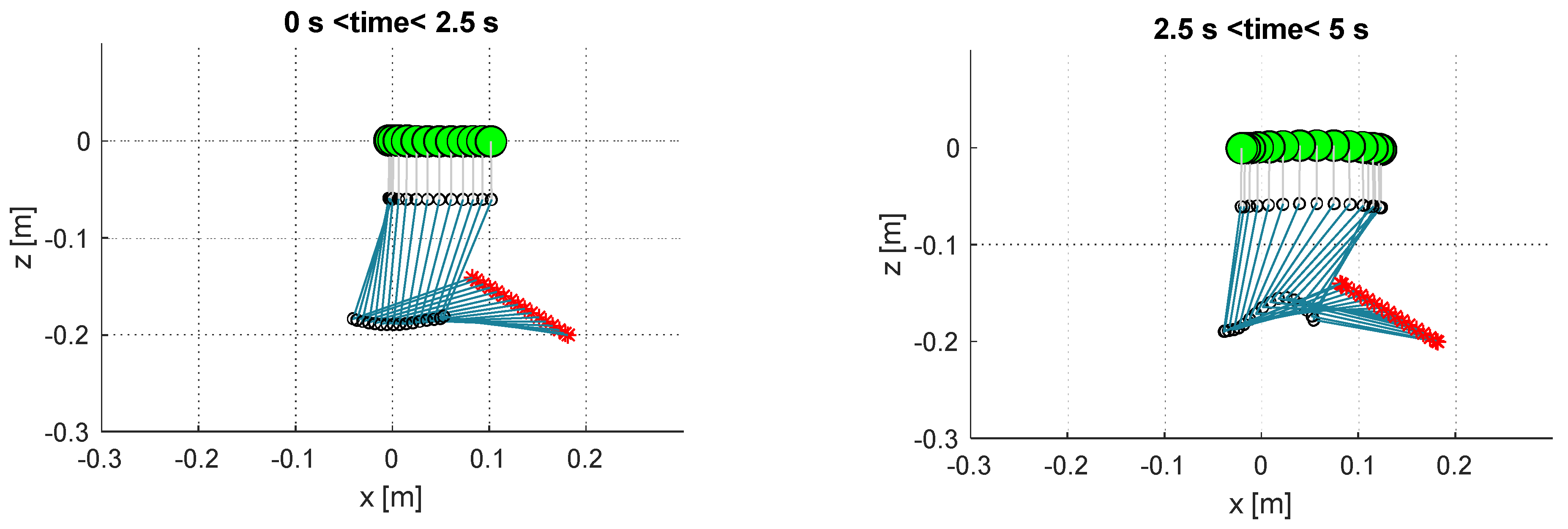
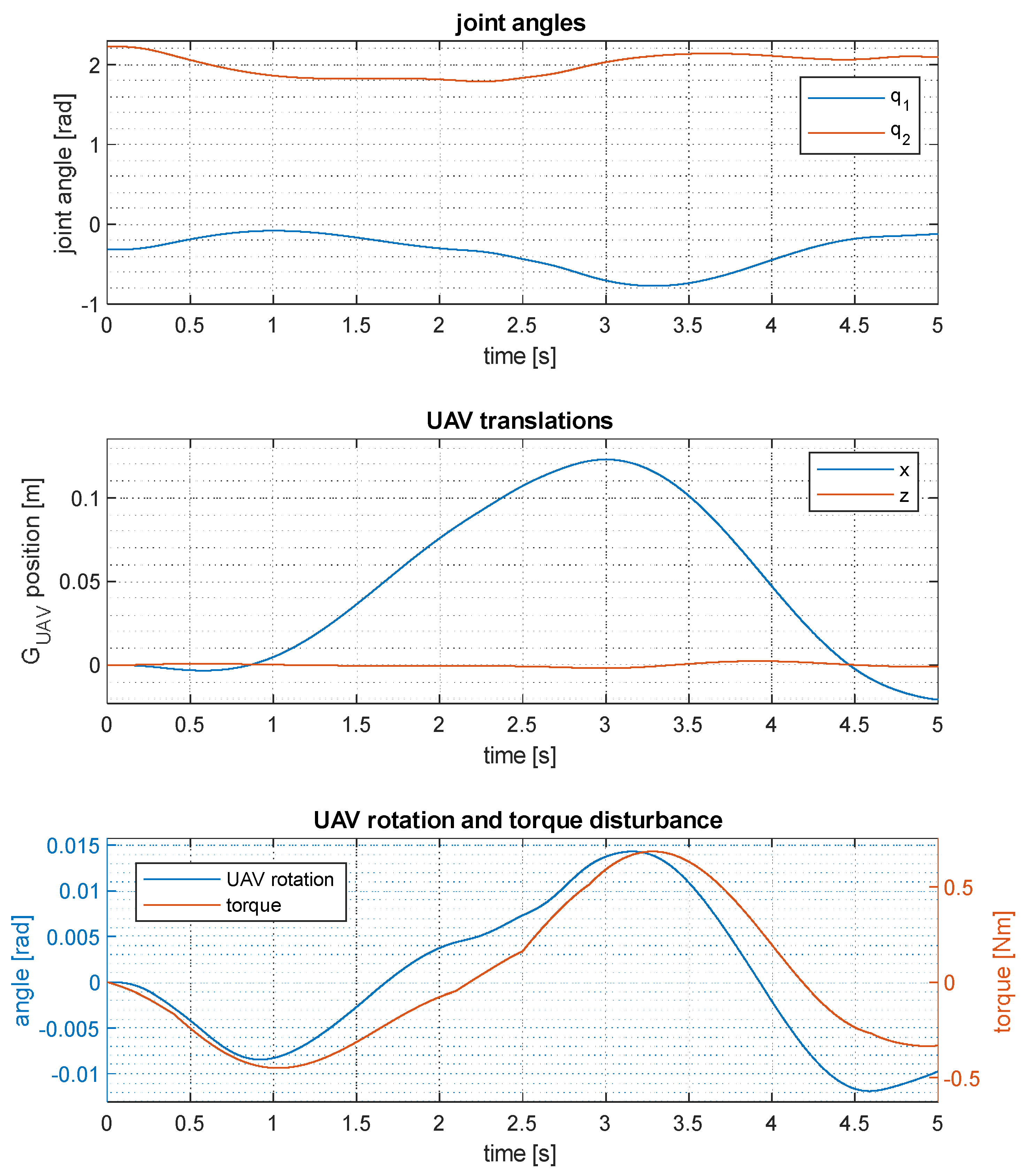
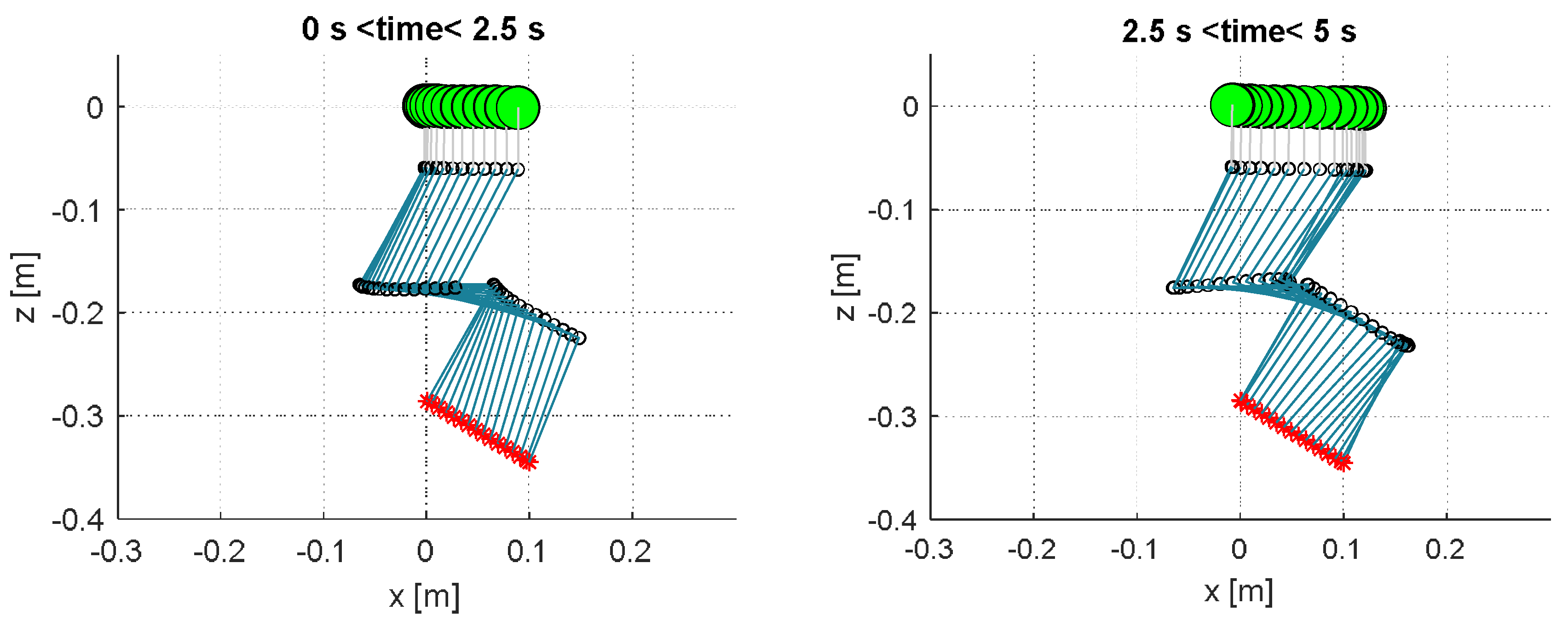
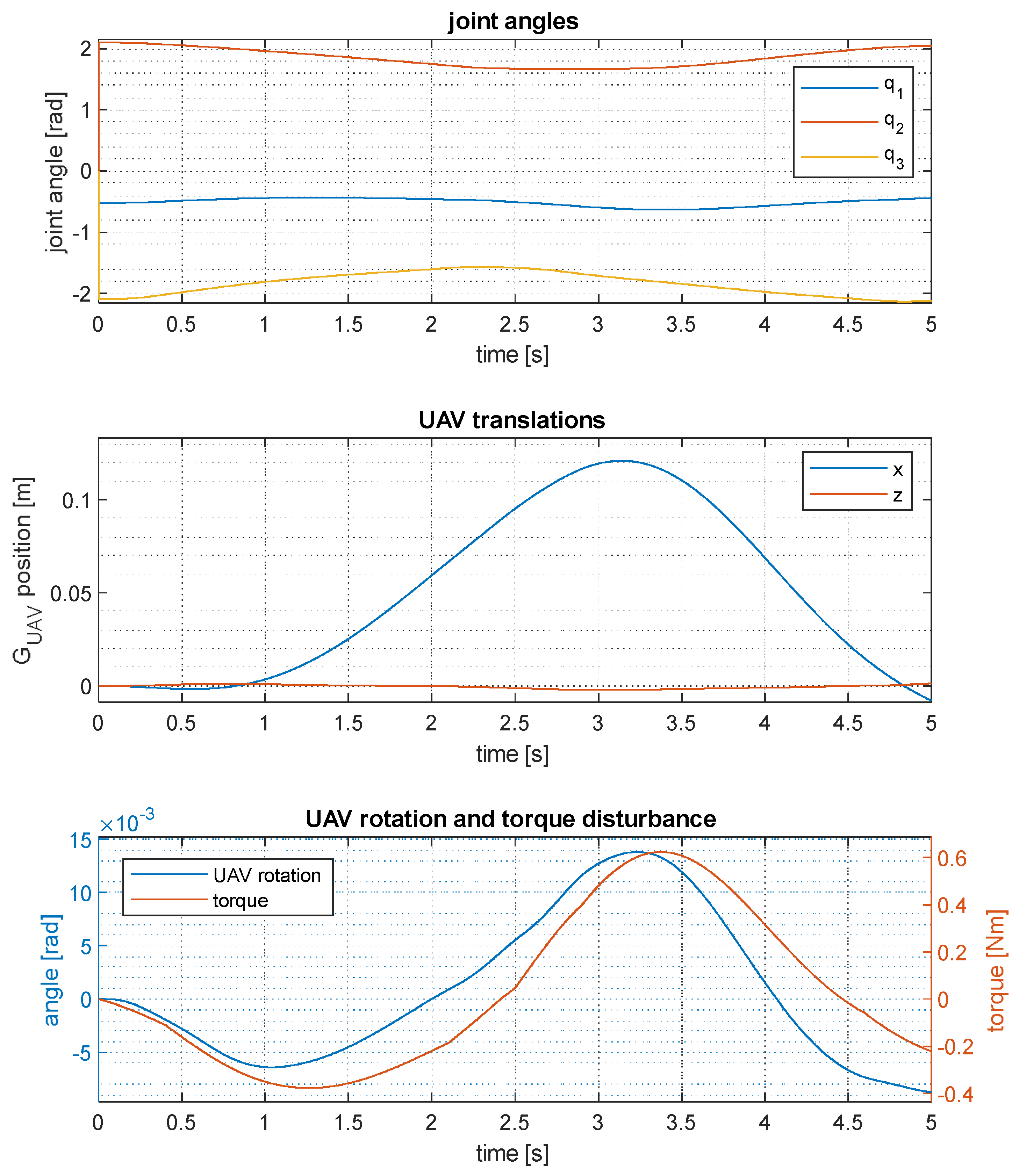
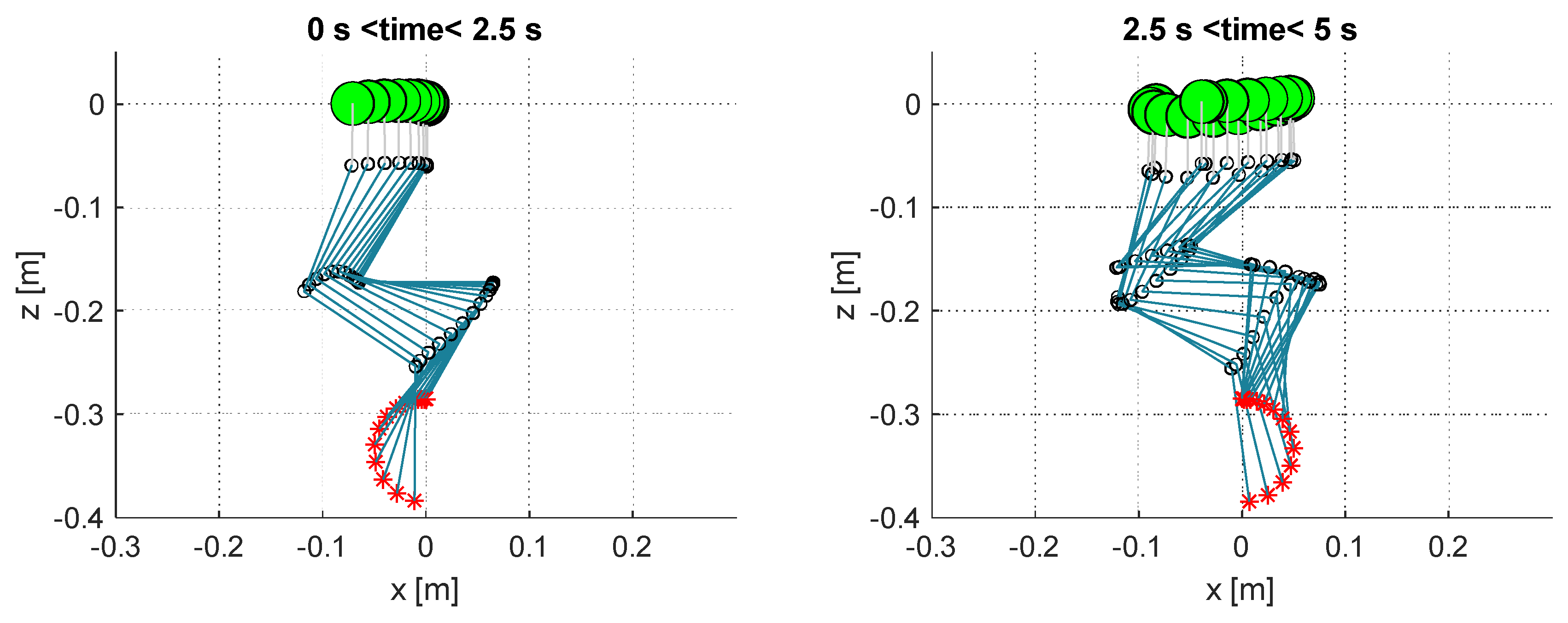
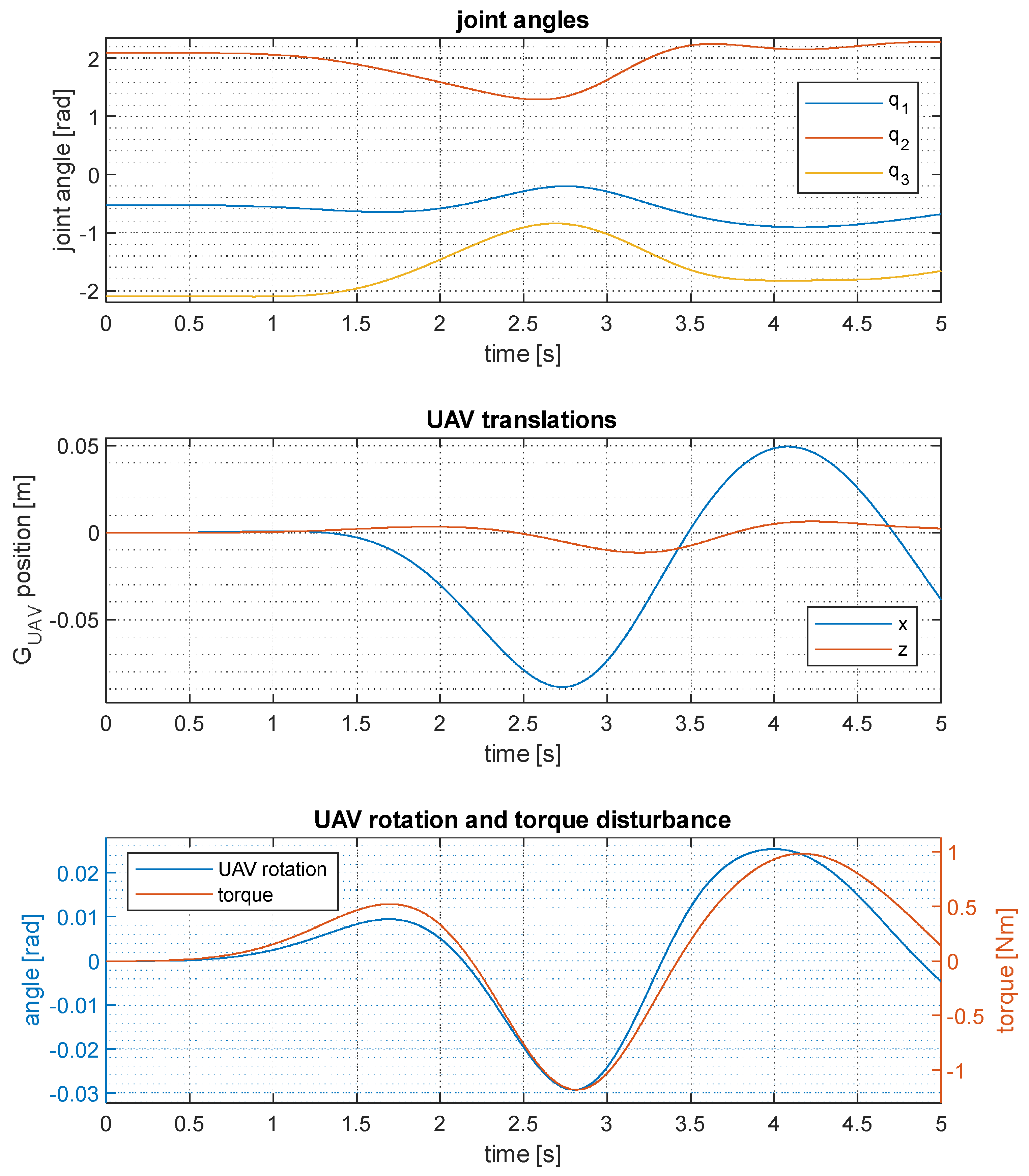

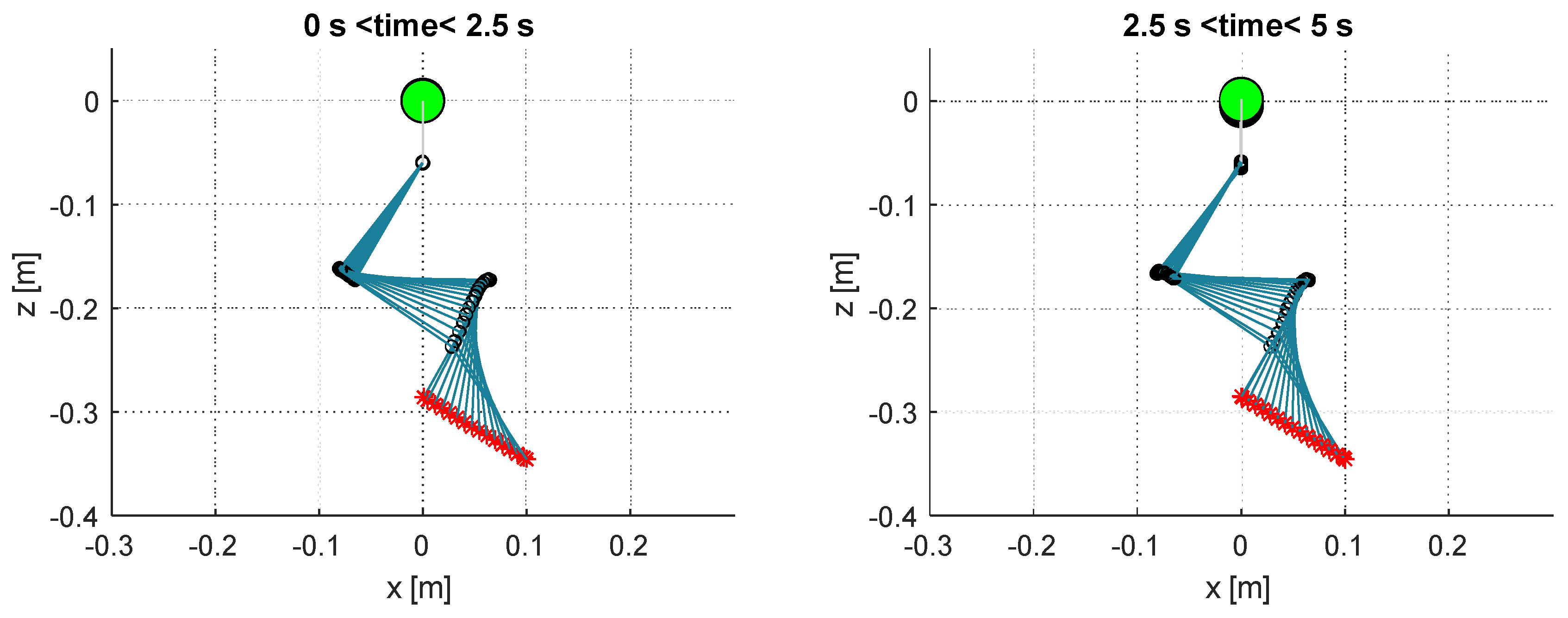
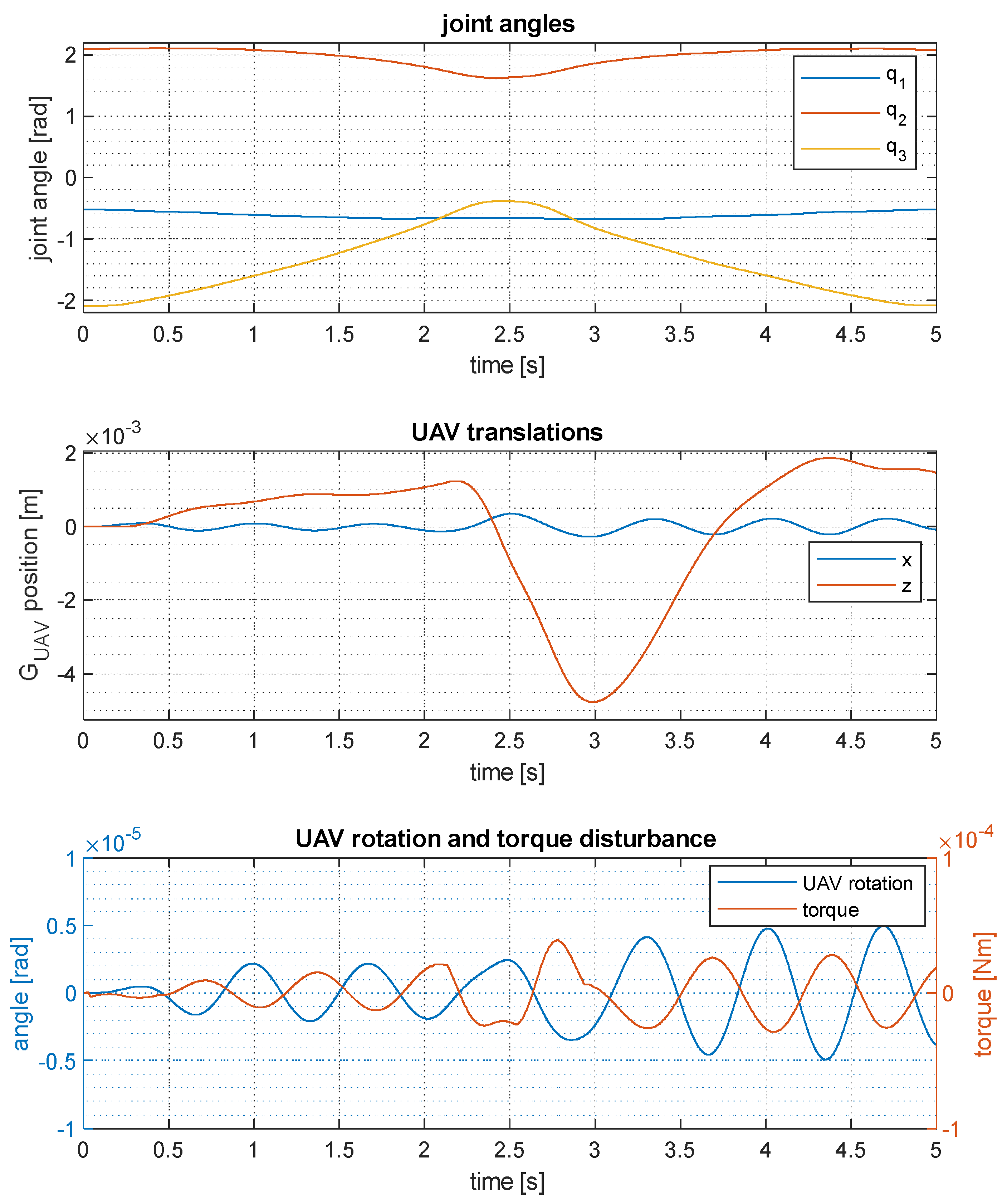
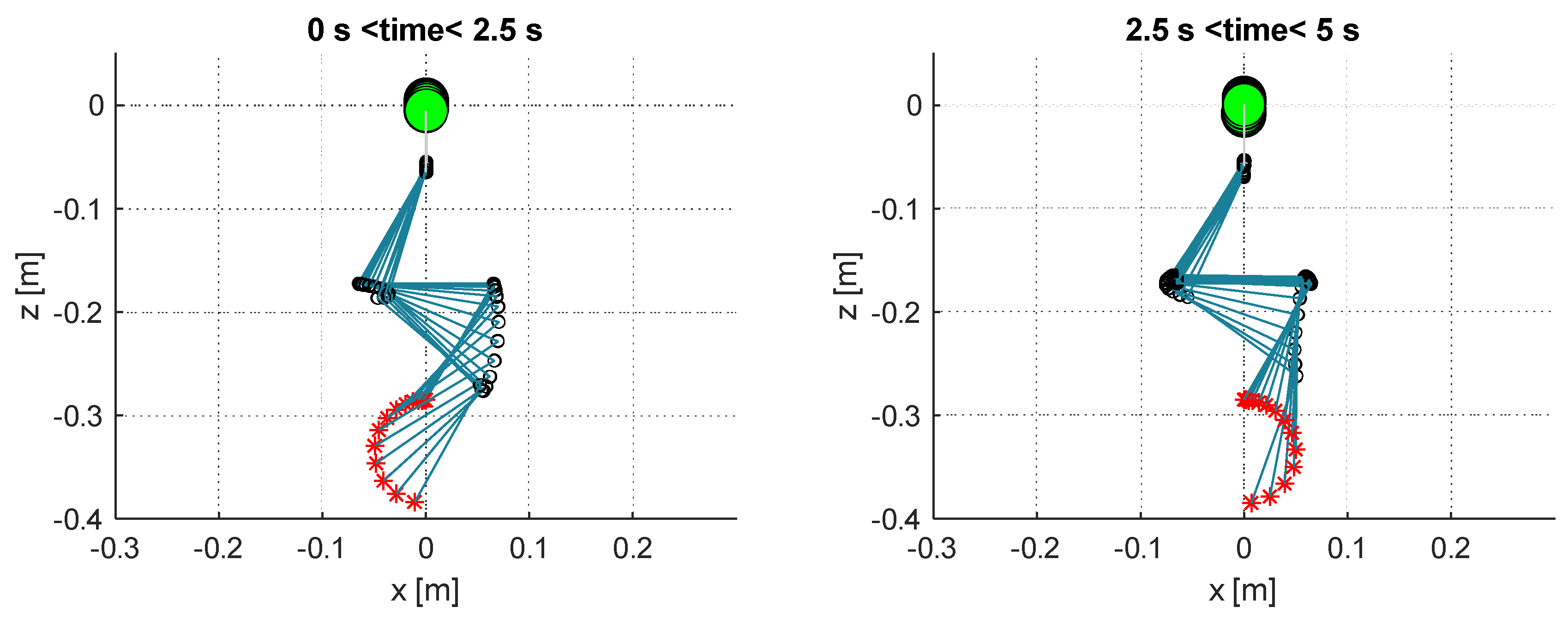
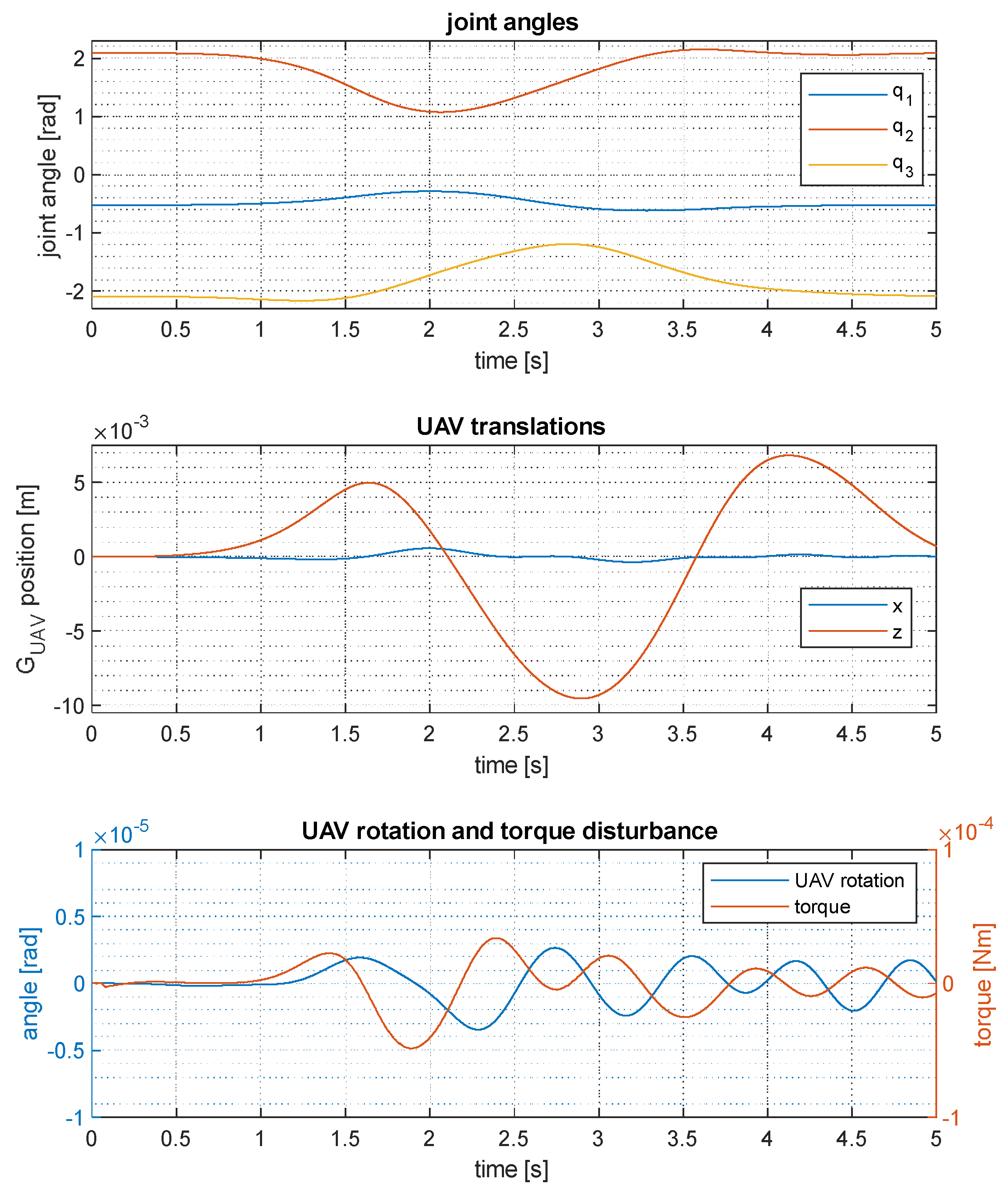
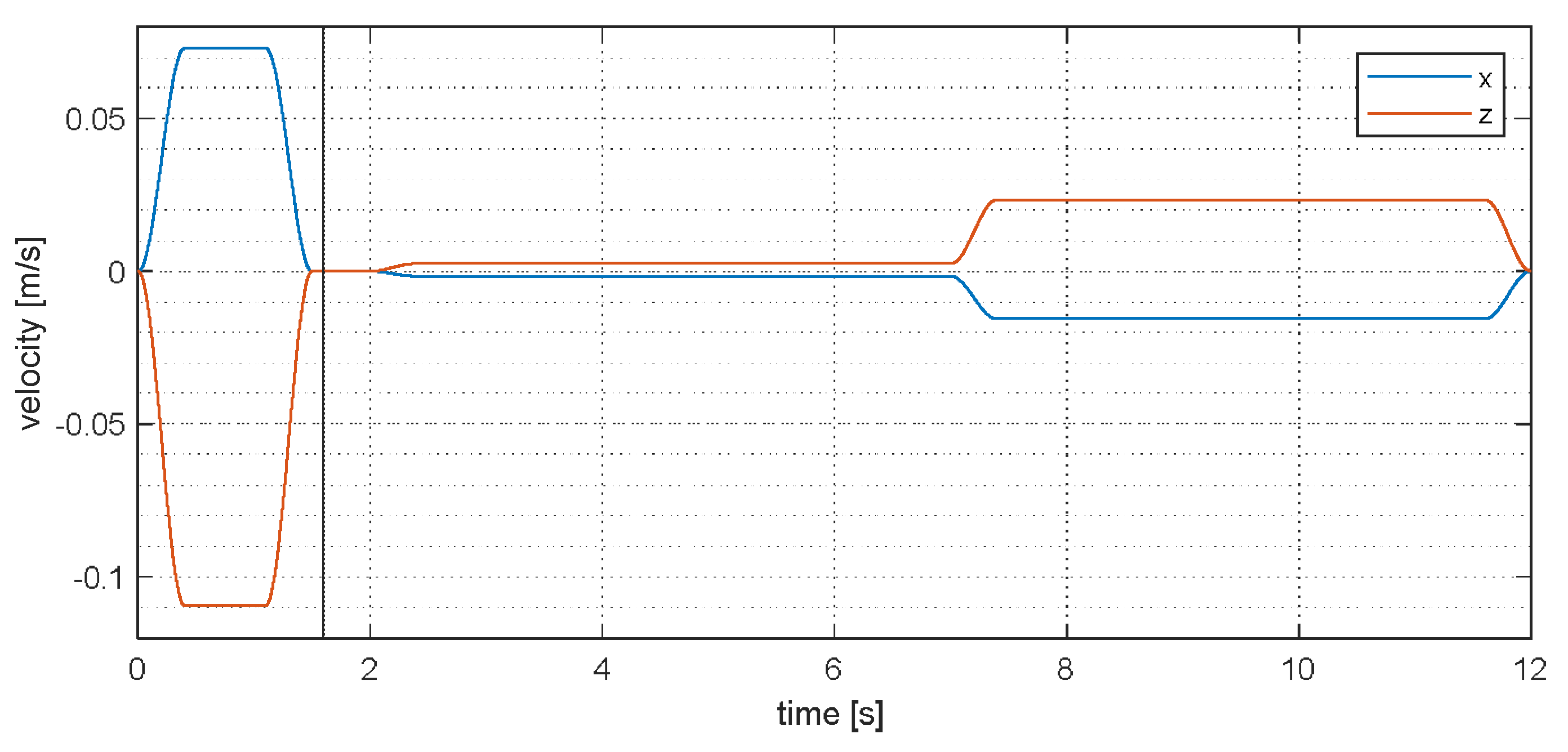
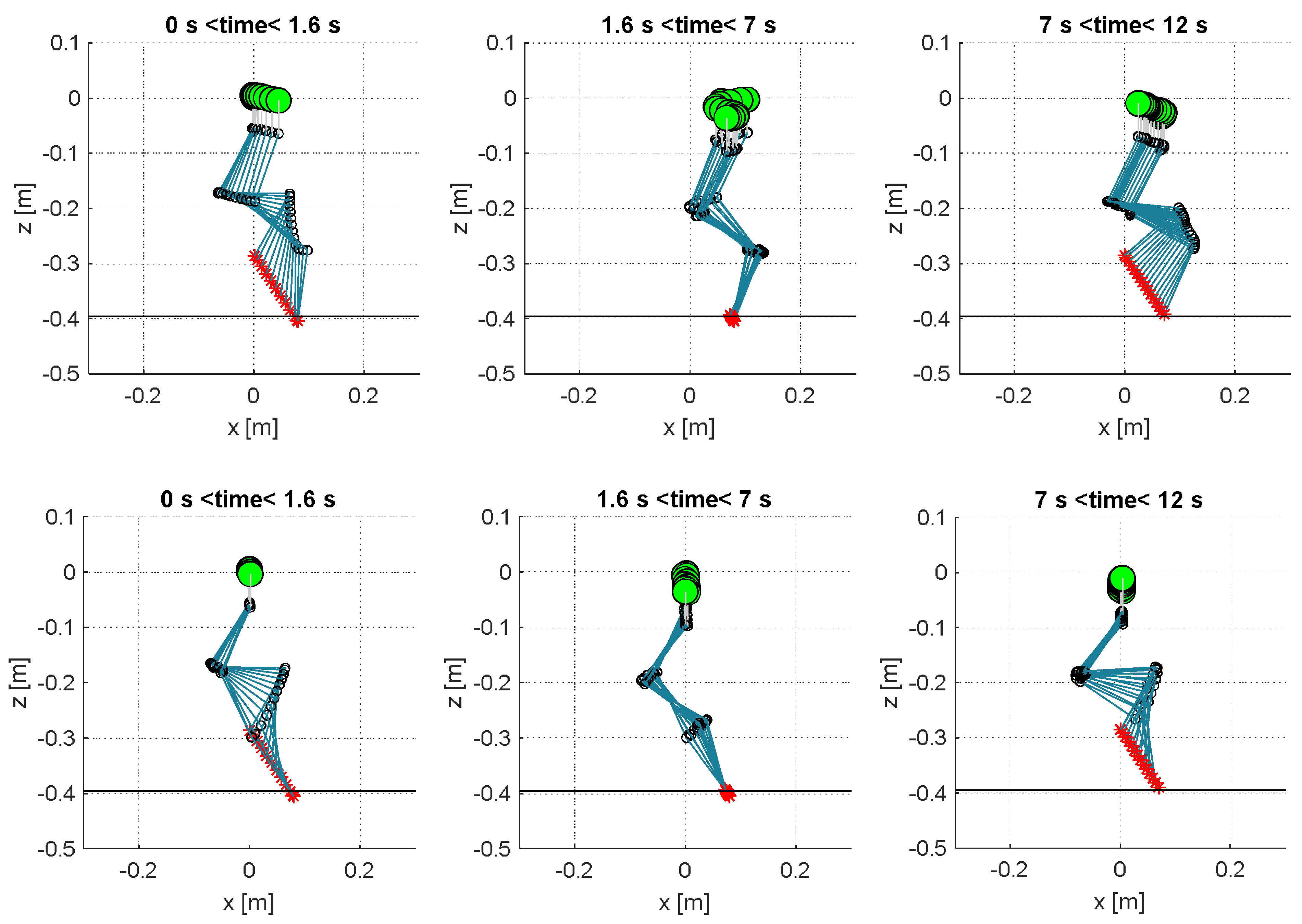
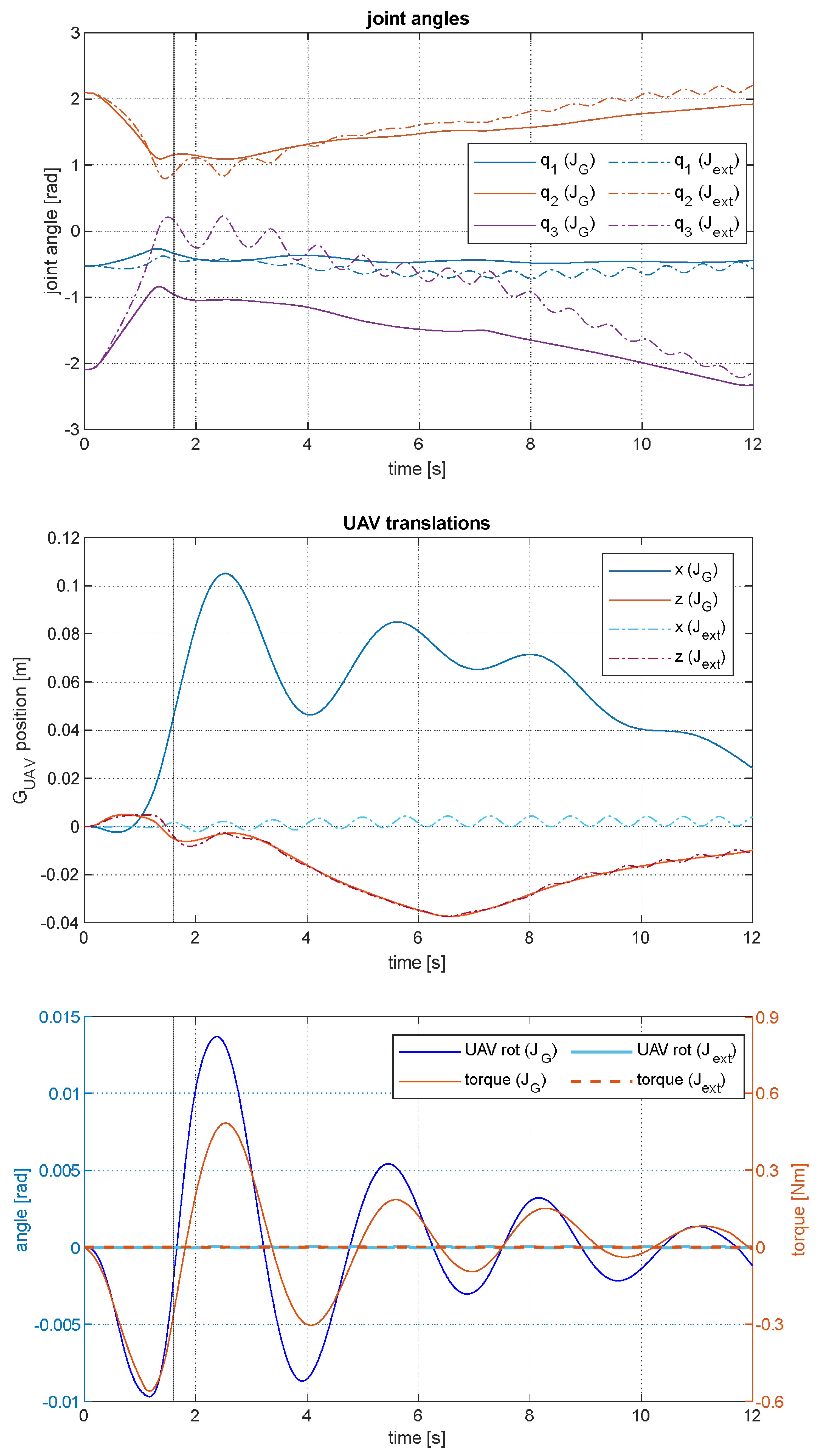
| Parameter | Description | Value | Unit |
|---|---|---|---|
| Mass of the UAV | 4.2 | kg | |
| Link mass | 1 | kg | |
| Moment of inertia (z) of the UAV | 0.4097 | kg m2 | |
| Moment of inertia (z) of Link | kg m2 | ||
| Link length | 0.13 | m | |
| Distance from joint to link CoG | 0.065 | m | |
| Distance from UAV CoG to manipulator joint 1 along UAV body x-axis | 0 | m | |
| Distance from UAV CoG to manipulator joint 1 along UAV body z-axis | −0.06 | m |
| Coordinate (i) | |||
|---|---|---|---|
| 37 | 18 | 8 | |
| 40 | 3 | 35 |
Publisher’s Note: MDPI stays neutral with regard to jurisdictional claims in published maps and institutional affiliations. |
© 2022 by the authors. Licensee MDPI, Basel, Switzerland. This article is an open access article distributed under the terms and conditions of the Creative Commons Attribution (CC BY) license (https://creativecommons.org/licenses/by/4.0/).
Share and Cite
Pasetto, A.; Vyas, Y.; Cocuzza, S. Zero Reaction Torque Trajectory Tracking of an Aerial Manipulator through Extended Generalized Jacobian. Appl. Sci. 2022, 12, 12254. https://doi.org/10.3390/app122312254
Pasetto A, Vyas Y, Cocuzza S. Zero Reaction Torque Trajectory Tracking of an Aerial Manipulator through Extended Generalized Jacobian. Applied Sciences. 2022; 12(23):12254. https://doi.org/10.3390/app122312254
Chicago/Turabian StylePasetto, Alberto, Yash Vyas, and Silvio Cocuzza. 2022. "Zero Reaction Torque Trajectory Tracking of an Aerial Manipulator through Extended Generalized Jacobian" Applied Sciences 12, no. 23: 12254. https://doi.org/10.3390/app122312254
APA StylePasetto, A., Vyas, Y., & Cocuzza, S. (2022). Zero Reaction Torque Trajectory Tracking of an Aerial Manipulator through Extended Generalized Jacobian. Applied Sciences, 12(23), 12254. https://doi.org/10.3390/app122312254







